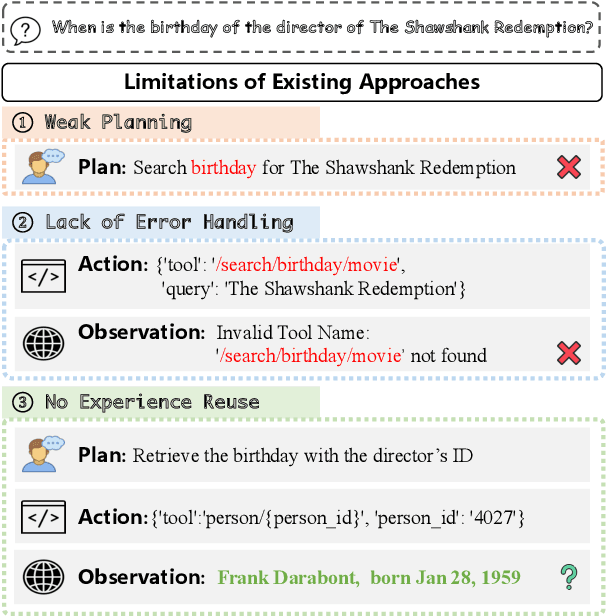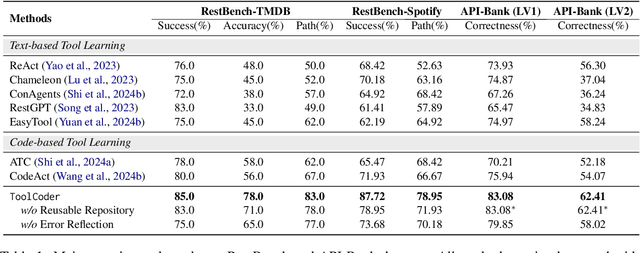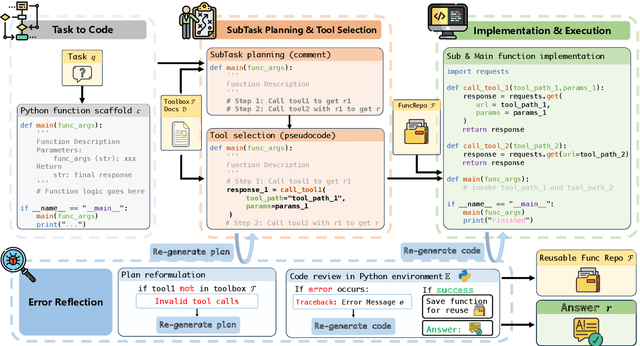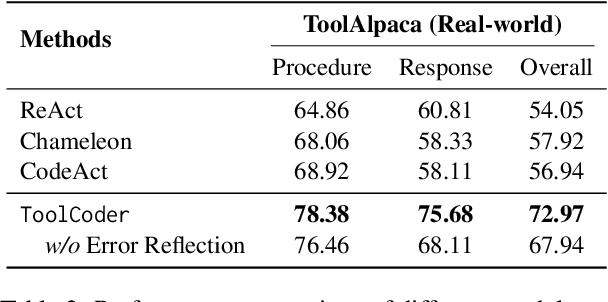Shuchang Tao
Omni-SafetyBench: A Benchmark for Safety Evaluation of Audio-Visual Large Language Models
Aug 10, 2025Abstract:The rise of Omni-modal Large Language Models (OLLMs), which integrate visual and auditory processing with text, necessitates robust safety evaluations to mitigate harmful outputs. However, no dedicated benchmarks currently exist for OLLMs, and prior benchmarks designed for other LLMs lack the ability to assess safety performance under audio-visual joint inputs or cross-modal safety consistency. To fill this gap, we introduce Omni-SafetyBench, the first comprehensive parallel benchmark for OLLM safety evaluation, featuring 24 modality combinations and variations with 972 samples each, including dedicated audio-visual harm cases. Considering OLLMs' comprehension challenges with complex omni-modal inputs and the need for cross-modal consistency evaluation, we propose tailored metrics: a Safety-score based on conditional Attack Success Rate (C-ASR) and Refusal Rate (C-RR) to account for comprehension failures, and a Cross-Modal Safety Consistency Score (CMSC-score) to measure consistency across modalities. Evaluating 6 open-source and 4 closed-source OLLMs reveals critical vulnerabilities: (1) no model excels in both overall safety and consistency, with only 3 models achieving over 0.6 in both metrics and top performer scoring around 0.8; (2) safety defenses weaken with complex inputs, especially audio-visual joints; (3) severe weaknesses persist, with some models scoring as low as 0.14 on specific modalities. Our benchmark and metrics highlight urgent needs for enhanced OLLM safety, providing a foundation for future improvements.
Incentivizing Strong Reasoning from Weak Supervision
May 28, 2025Abstract:Large language models (LLMs) have demonstrated impressive performance on reasoning-intensive tasks, but enhancing their reasoning abilities typically relies on either reinforcement learning (RL) with verifiable signals or supervised fine-tuning (SFT) with high-quality long chain-of-thought (CoT) demonstrations, both of which are expensive. In this paper, we study a novel problem of incentivizing the reasoning capacity of LLMs without expensive high-quality demonstrations and reinforcement learning. We investigate whether the reasoning capabilities of LLMs can be effectively incentivized via supervision from significantly weaker models. We further analyze when and why such weak supervision succeeds in eliciting reasoning abilities in stronger models. Our findings show that supervision from significantly weaker reasoners can substantially improve student reasoning performance, recovering close to 94% of the gains of expensive RL at a fraction of the cost. Experiments across diverse benchmarks and model architectures demonstrate that weak reasoners can effectively incentivize reasoning in stronger student models, consistently improving performance across a wide range of reasoning tasks. Our results suggest that this simple weak-to-strong paradigm is a promising and generalizable alternative to costly methods for incentivizing strong reasoning capabilities at inference-time in LLMs. The code is publicly available at https://github.com/yuanyige/w2sr.
Inference-time Alignment in Continuous Space
May 26, 2025Abstract:Aligning large language models with human feedback at inference time has received increasing attention due to its flexibility. Existing methods rely on generating multiple responses from the base policy for search using a reward model, which can be considered as searching in a discrete response space. However, these methods struggle to explore informative candidates when the base policy is weak or the candidate set is small, resulting in limited effectiveness. In this paper, to address this problem, we propose Simple Energy Adaptation ($\textbf{SEA}$), a simple yet effective algorithm for inference-time alignment. In contrast to expensive search over the discrete space, SEA directly adapts original responses from the base policy toward the optimal one via gradient-based sampling in continuous latent space. Specifically, SEA formulates inference as an iterative optimization procedure on an energy function over actions in the continuous space defined by the optimal policy, enabling simple and effective alignment. For instance, despite its simplicity, SEA outperforms the second-best baseline with a relative improvement of up to $ \textbf{77.51%}$ on AdvBench and $\textbf{16.36%}$ on MATH. Our code is publicly available at https://github.com/yuanyige/SEA
Incentivizing Reasoning from Weak Supervision
May 26, 2025Abstract:Large language models (LLMs) have demonstrated impressive performance on reasoning-intensive tasks, but enhancing their reasoning abilities typically relies on either reinforcement learning (RL) with verifiable signals or supervised fine-tuning (SFT) with high-quality long chain-of-thought (CoT) demonstrations, both of which are expensive. In this paper, we study a novel problem of incentivizing the reasoning capacity of LLMs without expensive high-quality demonstrations and reinforcement learning. We investigate whether the reasoning capabilities of LLMs can be effectively incentivized via supervision from significantly weaker models. We further analyze when and why such weak supervision succeeds in eliciting reasoning abilities in stronger models. Our findings show that supervision from significantly weaker reasoners can substantially improve student reasoning performance, recovering close to 94% of the gains of expensive RL at a fraction of the cost. Experiments across diverse benchmarks and model architectures demonstrate that weak reasoners can effectively incentivize reasoning in stronger student models, consistently improving performance across a wide range of reasoning tasks. Our results suggest that this simple weak-to-strong paradigm is a promising and generalizable alternative to costly methods for incentivizing strong reasoning capabilities at inference-time in LLMs. The code is publicly available at https://github.com/yuanyige/W2SR.
ToolCoder: A Systematic Code-Empowered Tool Learning Framework for Large Language Models
Feb 17, 2025



Abstract:Tool learning has emerged as a crucial capability for large language models (LLMs) to solve complex real-world tasks through interaction with external tools. Existing approaches face significant challenges, including reliance on hand-crafted prompts, difficulty in multi-step planning, and lack of precise error diagnosis and reflection mechanisms. We propose ToolCoder, a novel framework that reformulates tool learning as a code generation task. Inspired by software engineering principles, ToolCoder transforms natural language queries into structured Python function scaffold and systematically breaks down tasks with descriptive comments, enabling LLMs to leverage coding paradigms for complex reasoning and planning. It then generates and executes function implementations to obtain final responses. Additionally, ToolCoder stores successfully executed functions in a repository to promote code reuse, while leveraging error traceback mechanisms for systematic debugging, optimizing both execution efficiency and robustness. Experiments demonstrate that ToolCoder achieves superior performance in task completion accuracy and execution reliability compared to existing approaches, establishing the effectiveness of code-centric approaches in tool learning.
Revisiting Robust RAG: Do We Still Need Complex Robust Training in the Era of Powerful LLMs?
Feb 17, 2025Abstract:Retrieval-augmented generation (RAG) systems often suffer from performance degradation when encountering noisy or irrelevant documents, driving researchers to develop sophisticated training strategies to enhance their robustness against such retrieval noise. However, as large language models (LLMs) continue to advance, the necessity of these complex training methods is increasingly questioned. In this paper, we systematically investigate whether complex robust training strategies remain necessary as model capacity grows. Through comprehensive experiments spanning multiple model architectures and parameter scales, we evaluate various document selection methods and adversarial training techniques across diverse datasets. Our extensive experiments consistently demonstrate that as models become more powerful, the performance gains brought by complex robust training methods drop off dramatically. We delve into the rationale and find that more powerful models inherently exhibit superior confidence calibration, better generalization across datasets (even when trained with randomly selected documents), and optimal attention mechanisms learned with simpler strategies. Our findings suggest that RAG systems can benefit from simpler architectures and training strategies as models become more powerful, enabling more scalable applications with minimal complexity.
Accelerating the Surrogate Retraining for Poisoning Attacks against Recommender Systems
Aug 20, 2024



Abstract:Recent studies have demonstrated the vulnerability of recommender systems to data poisoning attacks, where adversaries inject carefully crafted fake user interactions into the training data of recommenders to promote target items. Current attack methods involve iteratively retraining a surrogate recommender on the poisoned data with the latest fake users to optimize the attack. However, this repetitive retraining is highly time-consuming, hindering the efficient assessment and optimization of fake users. To mitigate this computational bottleneck and develop a more effective attack in an affordable time, we analyze the retraining process and find that a change in the representation of one user/item will cause a cascading effect through the user-item interaction graph. Under theoretical guidance, we introduce \emph{Gradient Passing} (GP), a novel technique that explicitly passes gradients between interacted user-item pairs during backpropagation, thereby approximating the cascading effect and accelerating retraining. With just a single update, GP can achieve effects comparable to multiple original training iterations. Under the same number of retraining epochs, GP enables a closer approximation of the surrogate recommender to the victim. This more accurate approximation provides better guidance for optimizing fake users, ultimately leading to enhanced data poisoning attacks. Extensive experiments on real-world datasets demonstrate the efficiency and effectiveness of our proposed GP.
When to Trust LLMs: Aligning Confidence with Response Quality
Apr 26, 2024Abstract:Despite the success of large language models (LLMs) in natural language generation, much evidence shows that LLMs may produce incorrect or nonsensical text. This limitation highlights the importance of discerning when to trust LLMs, especially in safety-critical domains. Existing methods, which rely on verbalizing confidence to tell the reliability by inducing top-k responses and sampling-aggregating multiple responses, often fail, due to the lack of objective guidance of confidence. To address this, we propose CONfidence-Quality-ORDerpreserving alignment approach (CONQORD), leveraging reinforcement learning with a tailored dual-component reward function. This function encompasses quality reward and orderpreserving alignment reward functions. Specifically, the order-preserving reward incentivizes the model to verbalize greater confidence for responses of higher quality to align the order of confidence and quality. Experiments demonstrate that our CONQORD significantly improves the alignment performance between confidence levels and response accuracy, without causing the model to become over-cautious. Furthermore, the aligned confidence provided by CONQORD informs when to trust LLMs, and acts as a determinant for initiating the retrieval process of external knowledge. Aligning confidence with response quality ensures more transparent and reliable responses, providing better trustworthiness.
Robust Recommender System: A Survey and Future Directions
Sep 05, 2023



Abstract:With the rapid growth of information, recommender systems have become integral for providing personalized suggestions and overcoming information overload. However, their practical deployment often encounters "dirty" data, where noise or malicious information can lead to abnormal recommendations. Research on improving recommender systems' robustness against such dirty data has thus gained significant attention. This survey provides a comprehensive review of recent work on recommender systems' robustness. We first present a taxonomy to organize current techniques for withstanding malicious attacks and natural noise. We then explore state-of-the-art methods in each category, including fraudster detection, adversarial training, certifiable robust training against malicious attacks, and regularization, purification, self-supervised learning against natural noise. Additionally, we summarize evaluation metrics and common datasets used to assess robustness. We discuss robustness across varying recommendation scenarios and its interplay with other properties like accuracy, interpretability, privacy, and fairness. Finally, we delve into open issues and future research directions in this emerging field. Our goal is to equip readers with a holistic understanding of robust recommender systems and spotlight pathways for future research and development.
IDEA: Invariant Causal Defense for Graph Adversarial Robustness
May 25, 2023



Abstract:Graph neural networks (GNNs) have achieved remarkable success in various tasks, however, their vulnerability to adversarial attacks raises concerns for the real-world applications. Existing defense methods can resist some attacks, but suffer unbearable performance degradation under other unknown attacks. This is due to their reliance on either limited observed adversarial examples to optimize (adversarial training) or specific heuristics to alter graph or model structures (graph purification or robust aggregation). In this paper, we propose an Invariant causal DEfense method against adversarial Attacks (IDEA), providing a new perspective to address this issue. The method aims to learn causal features that possess strong predictability for labels and invariant predictability across attacks, to achieve graph adversarial robustness. Through modeling and analyzing the causal relationships in graph adversarial attacks, we design two invariance objectives to learn the causal features. Extensive experiments demonstrate that our IDEA significantly outperforms all the baselines under both poisoning and evasion attacks on five benchmark datasets, highlighting the strong and invariant predictability of IDEA. The implementation of IDEA is available at https://anonymous.4open.science/r/IDEA_repo-666B.
 Add to Chrome
Add to Chrome Add to Firefox
Add to Firefox Add to Edge
Add to Edge